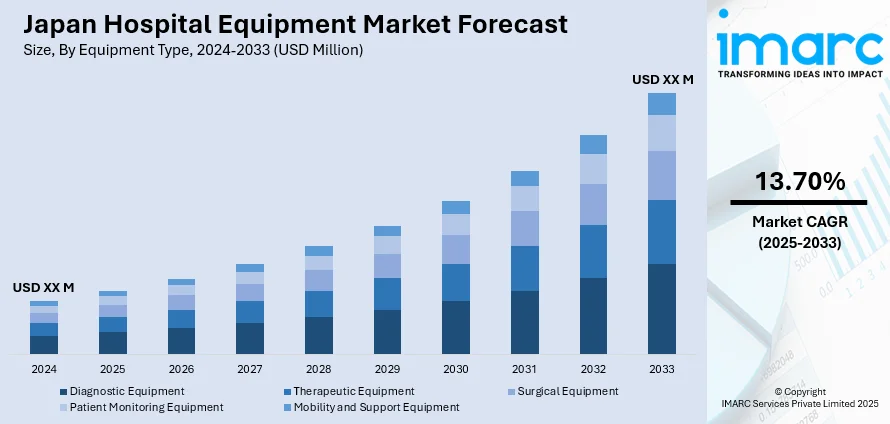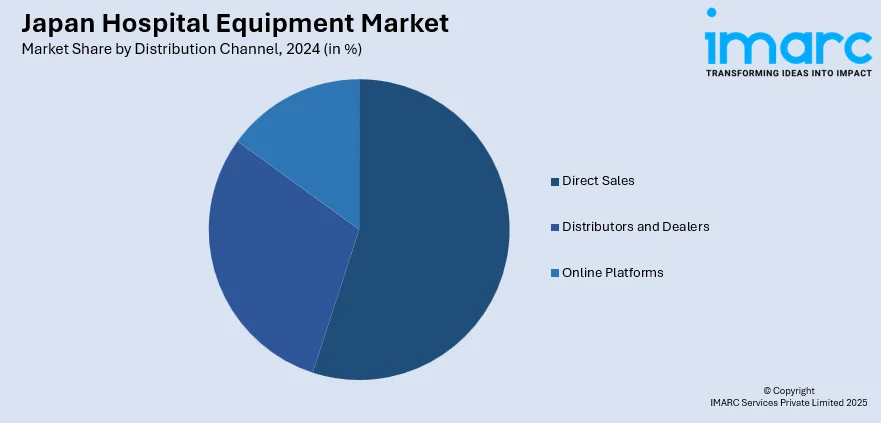
Japan Hospital Equipment Market Size, Share, Trends and Forecast by Equipment Type, Distribution Channel, End User, and Region, 2025-2033
Japan Hospital Equipment Market Overview:
The Japan hospital equipment market size is projected to exhibit a growth rate (CAGR) of 13.70% during 2025-2033. The market is experiencing significant growth driven by developments in medical technologies, rising healthcare demands, and an aging population. The adoption of state-of-the-art medical devices, including robotic surgeries and AI-powered diagnostics, is also accelerating. Increased investments in healthcare infrastructure, growing focus on improving patient care and rising demand for innovative and efficient hospital equipment are further contributing to the overall Japan hospital equipment market share.
|
Report Attribute
|
Key Statistics
|
|---|---|
|
Base Year
|
2024
|
|
Forecast Years
|
2025-2033
|
|
Historical Years
|
2019-2024
|
| Market Growth Rate 2025-2033 | 13.70% |
Japan Hospital Equipment Market Trends:
Technological Advancements
Technological innovations are playing a central role in boosting the growth of the Japan hospital equipment market. The incorporation of artificial intelligence (AI), robotics, and automation is transforming the manner in which healthcare services are provided. AI-based diagnostic equipment is facilitating quicker and more precise detection of diseases, while robotic surgical systems are enhancing surgery accuracy, decreasing recovery periods, and avoiding human error. For instance, in January 2025, Monitor Corporation launched its AI lung cancer diagnosis tool, MONCAD CTLN, in Japan through a partnership with Doctor-NET. This software helps radiologists identify cancer through chest CT scans. With Japan facing a shortage of radiologists, the tool aims to enhance diagnostic efficiency in healthcare. Moreover, automation in patient monitoring systems is facilitating real-time monitoring of patient vitals to allow healthcare professionals to take quick action in response to any alteration in a patient's state. Increased uptake of these technologies is compelling hospitals and healthcare providers to invest in sophisticated medical equipment to deliver high-quality care. As Japan keeps revolutionizing healthcare technology, these innovations not only enhance patient care but also ensure more streamlined hospital operations, thus driving Japan hospital equipment market growth.

Rising Geriatric Population
Japan's aging population is a key factor driving the demand for medical equipment in the country. With one of the world's highest life expectancies, Japan faces a growing need for healthcare services and advanced medical equipment to address age-related conditions such as chronic diseases, mobility impairments, and cognitive decline. According to industry reports, Japan's elderly population reached a record 36.25 million, comprising 29.3% of the overall population. Those aged 75 and older increased by 710,000 to 20.76 million, while seniors aged 80 and above rose by 310,000 to 12.9 million. This population shift is growing the demand for diagnostic equipment, therapy equipment, and mobility devices that address the needs of the elderly population. Since the elderly population tends to need more medical services and extended care, hospital facilities and healthcare facilities are making investments in technologies and equipment specifically designed to address these needs. The increase in age-related illnesses also contributes to the growth of rehabilitation and monitoring devices, including mobility devices, blood pressure meters, and home care equipment. Such high demand, underpinned by Japan's aging population, is driving the growth in the hospital equipment market.
Japan Hospital Equipment Market Segmentation:
IMARC Group provides an analysis of the key trends in each segment of the market, along with forecasts at the country and regional levels for 2025-2033. Our report has categorized the market based on equipment type, distribution channel, and end user.
Equipment Type Insights:
- Diagnostic Equipment
- X-Ray Machines
- MRI Scanners
- CT Scanners
- Ultrasound Devices
- Endoscopy Equipment
- Therapeutic Equipment
- Ventilators
- Dialysis Machines
- Infusion Pumps
- Laser Therapy Devices
- Surgical Equipment
- Electrosurgical Devices
- Surgical Navigation Systems
- Endoscopic Instruments
- Patient Monitoring Equipment
- ECG Monitors
- Blood Pressure Monitors
- Pulse Oximeters
- Fetal Monitoring Systems
- Mobility and Support Equipment
- Wheelchairs and Stretchers
- Hospital Beds
- Patient Lifting Equipment
The report has provided a detailed breakup and analysis of the market based on the equipment type. This includes diagnostic equipment (X-Ray machines, MRI scanners, CT scanners, ultrasound devices, and endoscopy equipment), therapeutic equipment (ventilators, dialysis machines, infusion pumps, and laser therapy devices), surgical equipment (electrosurgical devices, surgical navigation systems, and endoscopic instruments), patient monitoring equipment (ECG monitors, blood pressure monitors, pulse oximeters, and fetal monitoring systems), and mobility and support equipment (wheelchairs and stretchers, hospital beds, and patient lifting equipment).
Distribution Channel Insights:

- Direct Sales
- Distributors and Dealers
- Online Platforms
A detailed breakup and analysis of the market based on the distribution channel have also been provided in the report. This includes direct sales, distributors and dealers, and online platforms.
End User Insights:
- Hospitals and Clinics
- Diagnostic Centers
- Ambulatory Surgical Centers
- Others
A detailed breakup and analysis of the market based on the end user have also been provided in the report. This includes hospitals and clinics, diagnostic centers, ambulatory surgical centers, and others.
Regional Insights:
- Kanto Region
- Kansai/Kinki Region
- Central/Chubu Region
- Kyushu-Okinawa Region
- Tohoku Region
- Chugoku Region
- Hokkaido Region
- Shikoku Region
The report has also provided a comprehensive analysis of all the major regional markets, which include Kanto Region, Kansai/Kinki Region, Central/Chubu Region, Kyushu-Okinawa Region, Tohoku Region, Chugoku Region, Hokkaido Region, and Shikoku Region.
Competitive Landscape:
The market research report has also provided a comprehensive analysis of the competitive landscape. Competitive analysis such as market structure, key player positioning, top winning strategies, competitive dashboard, and company evaluation quadrant has been covered in the report. Also, detailed profiles of all major companies have been provided.
Japan Hospital Equipment Market News:
- In November 2024, Asahi Kasei Medical Co., Ltd. announced the launch of "TrachFlush®," an innovative endotracheal tube cuff inflator designed to enhance tracheal suctioning during mechanical ventilation. This device aims to reduce patient discomfort and healthcare provider workload by maintaining cuff pressure and enabling quick cuff adjustments for effective airway clearance.
- In September 2023, Otsuka Pharmaceutical Factory launched the "Tumguide LED Light Source" and "Tumguide Fiber," innovative medical devices designed to verify nasogastric tube placement. By utilizing optical fiber technology, Tumguide provides visual confirmation of the tube tip position, thereby reducing patient risk, healthcare workload, and enhancing safety in enteral nutrition management.
Japan Hospital Equipment Market Report Coverage:
| Report Features | Details |
|---|---|
| Base Year of the Analysis | 2024 |
| Historical Period | 2019-2024 |
| Forecast Period | 2025-2033 |
| Units | Million USD |
| Scope of the Report |
Exploration of Historical Trends and Market Outlook, Industry Catalysts and Challenges, Segment-Wise Historical and Future Market Assessment:
|
| Equipment Types Covered |
|
| Distribution Channels Covered | Direct Sales, Distributors and Dealers, Online Platforms |
| End Users Covered | Hospitals and Clinics, Diagnostic Centers, Ambulatory Surgical Centers, Others |
| Regions Covered | Kanto Region, Kansai/Kinki Region, Central/Chubu Region, Kyushu-Okinawa Region, Tohoku Region, Chugoku Region, Hokkaido Region, Shikoku Region |
| Customization Scope | 10% Free Customization |
| Post-Sale Analyst Support | 10-12 Weeks |
| Delivery Format | PDF and Excel through Email (We can also provide the editable version of the report in PPT/Word format on special request) |
Key Questions Answered in This Report:
- How has the Japan hospital equipment market performed so far and how will it perform in the coming years?
- What is the breakup of the Japan hospital equipment market on the basis of equipment type?
- What is the breakup of the Japan hospital equipment market on the basis of distribution channel?
- What is the breakup of the Japan hospital equipment market on the basis of end user?
- What is the breakup of the Japan hospital equipment market on the basis of region?
- What are the various stages in the value chain of the Japan hospital equipment market?
- What are the key driving factors and challenges in the Japan hospital equipment market?
- What is the structure of the Japan hospital equipment market and who are the key players?
- What is the degree of competition in the Japan hospital equipment market?
Key Benefits for Stakeholders:
- IMARC’s industry report offers a comprehensive quantitative analysis of various market segments, historical and current market trends, market forecasts, and dynamics of the Japan hospital equipment market from 2019-2033.
- The research report provides the latest information on the market drivers, challenges, and opportunities in the Japan hospital equipment market.
- Porter's five forces analysis assist stakeholders in assessing the impact of new entrants, competitive rivalry, supplier power, buyer power, and the threat of substitution. It helps stakeholders to analyze the level of competition within the Japan hospital equipment industry and its attractiveness.
- Competitive landscape allows stakeholders to understand their competitive environment and provides an insight into the current positions of key players in the market.
Need more help?
- Speak to our experienced analysts for insights on the current market scenarios.
- Include additional segments and countries to customize the report as per your requirement.
- Gain an unparalleled competitive advantage in your domain by understanding how to utilize the report and positively impacting your operations and revenue.
- For further assistance, please connect with our analysts.
 Request Customization
Request Customization
 Speak to an Analyst
Speak to an Analyst
 Request Brochure
Request Brochure
 Inquire Before Buying
Inquire Before Buying




.webp)




.webp)












